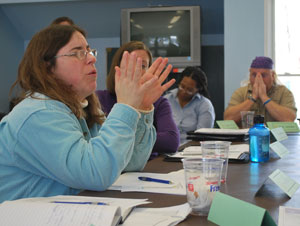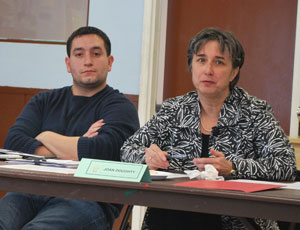Water Main Project Set for Bryant Area

Jerry Hancock, Ann Arbor's stormwater and floodplain programs coordinator, explains how soil composition in the Bryant neighborhood factors in the area's water problems. (Photos by the writer.)
A major project to replace water mains and resurface roads in the Bryant neighborhood will get under way this spring, part of a broader plan to address the area’s chronic drainage problems and other issues.
At a Jan. 14 neighborhood meeting, Ann Arbor city staff gave an overview of the project, which included an historical look at the subdivision off Stone School Road, just south of I-94.
The meeting at the Bryant Community Center – organized by the nonprofit Community Action Network and attended by residents, city and county elected officials and staff, among others – is the latest in a series of efforts to deal with a wide range of challenges to one of the city’s predominantly low-income neighborhoods.
At the end of Thursday’s two-hour session, a question raised by one of the residents – “Is there a happy ending to all of this?” – might best be summarized by the answer, “It depends.”
Water Mains, Roads
Anne Warrow, a civil engineer and project manager for the city of Ann Arbor, presented details of the $1.1 million water main replacement, set to begin in mid-May. Over the past few years, more than 25 water main breaks have been reported in the subdivision of 259 homes, built between 1969-71. The city plans to replace 9,000 feet of corroding cast-iron pipe with polyethylene-encased ductile iron pipe. Typical projects are smaller, in the 4,000-foot range, Warrow said. [Link to map showing water main breaks and location of planned water main replacement.]
The new water mains will run along Champagne, the primary street through the subdivision, from Stone School Road to Shadowood Drive, as well as in most of the small courts off of Champagne. Mains will also be replaced on Hemlock and its small courts. Only four courts off of Champagne – Santa Rosa, Blain, Jay Lee and Burlingame – won’t be receiving replacement water mains, Warrow said, because existing mains aren’t causing problems there.
In addition, four new fire hydrants will be installed in Metroview, Faust, Trowbridge and West Eden courts, on the north side of the subdivision. Warrow said a general rule of thumb is to have hydrants no more than 250 feet apart, and there are currently no hydrants in those courts.
The city expects to pay for the water main replacements with low-interest loans, Warrow said. The project will be funded from the drinking water revolving fund, administered by the Michigan Department of Environmental Quality. The loans will be repaid out of the city’s water utilities fund.
Funding for the second part of the project – street resurfacing, estimated at about $3 million – would come from the city’s street reconstruction millage. However, it’s unclear how much funding will be available from the millage. That question hinges on whether the city is successful in getting federal funding to replace the East Stadium bridges. If the city doesn’t get a federal grant that it has applied for, then millage funds will be used for the bridges and other street projects will be postponed. Depending on how this plays out, street resurfacing in the Bryant neighborhood could happen in phases, Warrow said.

Anne Warrow, a civil engineer and project manager for the city of Ann Arbor, explains how water mains will be replaced in the Bryant neighborhood, starting this spring.
To prepare for the entire project, city staff took soil borings throughout the area, including 32 on road surfaces and another 25 in unpaved spots, boring down as deep as 20 feet. The findings were consistent throughout, Warrow said – the soil is primarily silty clay, with some sand.
That news wasn’t a surprise to residents, confirming what they already suspected. It also means that one of the strategies they’d considered to help manage drainage problems – installing French drains to funnel water away from the houses – wouldn’t be effective, because clay soil takes so long to absorb water runoff.
During the entire project, on-street parking will be limited, Warrow said, though residents will have access to their homes throughout construction. Roads will be dug up to put in the new pipes, then the trenches will be backfilled with stones. Workers will pressure-test the new water main, and flush it to test the quality of the water, making sure it’s clean. The testing phase will take a couple of weeks, she said. Then they’ll do the final tie-in, transferring each home’s water connection to the new main.
Residents won’t be without water except for a short period during the tie-in to their homes, Warrow said. However, she added, “the unforeseen may occur.” One of the risks is potential breaks in the old water main as the new one is being constructed, she said.
As part of the project, the public storm sewer system in the neighborhood will be cleaned. However, Warrow acknowledged that many of the drainage problems experienced in the area were caused by issues with the subdivision’s private drainage system, which hooks into the city’s storm sewer system. Those private systems won’t be part of the upcoming project.
Another challenge is that the land is virtually flat – a 1% slope on most properties doesn’t allow water to drain well.
An Historical View
Why isn’t there more of a slope on these lots? “That’s how it was designed, unfortunately,” Jerry Hancock told the group on Thursday. Hancock is the city’s stormwater and floodplain programs coordinator, and gave a presentation that included an historical look at the neighborhood to explain why water problems exist.
He first showed an aerial photo of the area taken in 1947, before it was developed. The west portion was an orchard, the eastern section appeared to be lightly wooded. To the south was a gravel pit. The next aerial photo, taken in 1960, showed only one major change: a wide east-west stretch of I-94 now appeared in the photo. The interstate was built just north of the land that would later become the Arbor Oaks subdivision, known as the Bryant neighborhood.
Hancock then pulled out yet another map showing pre-development soil compositions. One theory to explain the neighborhood’s chronic water problems is that the development had been built on wetlands, but Hancock said that doesn’t appear to be the case. Pre-development, there were a range of soil types recorded, from sandy loam to silty clay loam – more variety than was indicated when the city recently took soil samples. The fact that most of the soil in the neighborhood now is silty clay supports the theory that when the subdivision was constructed, soil from one section was spread throughout the entire area by construction workers.
Looking at these and other maps, Hancock said some things stand out. The land is essentially flat, and the lots weren’t graded so that water would drain away from the houses. In many cases, the crawl spaces are below grade, he said. There’s also a high water table on the east side of the neighborhood, which contributes to water problems. Given all of this, Hancock said it’s not surprising to see a high number of houses with mold and drainage problems.
For some of the homes located on the northern edge of the subdivision, it might be possible to redirect water toward culverts running along the I-94 expressway, Hancock said. However, he cautioned that it would only address a few lots: “It’s not going to solve everyone’s problem.”
City vs. Homeowner Responsibility
One of the themes that emerged from Thursday’s meeting was the distinction between what the city can do, and what remains the homeowner’s responsibility.
Several residents brought up the issue of drains on the individual lots, which were intended to feed into the city’s storm sewer system. Over the years, those drains – many located in backyards – have become covered or clogged. In some cases, city staff said it’s unclear if the drains shown on the developer’s proposed site plan ever got built.

Don Wakefield, a resident of the Bryant neighborhood, said problems with the drains in many backyards contribute to the area's flooding problems.
Molly Wade, the city’s water quality manager, said that over the next few weeks workers would be coming into the neighborhood and cleaning the city’s storm water and sewer systems. As part of that work, they’d also be running a camera through the city’s pipes to get a better idea about the condition of the system, she said.
Resident Don Wakefield said part of the issue is that there aren’t sufficient openings into the city’s system to be able to identify where problems are occurring. He said the drain in his backyard isn’t working, but there’s no manhole opening on the street to allow him to get access to the pipes on his property.
Paul Cartman, a resident who also owns several rental properties in the neighborhood, asked about the possibility of the city putting in edge drains as part of its water main and road resurfacing project. It was an issue he raised at a previous neighborhood meeting as well. [See Chronicle coverage: "Bryant Neighbors Dig Into Drainage"]
Anne Warrow, a city project manager, said that because most homes in the neighborhood don’t have footing drains, which are designed to divert water away from a house’s foundation, installing edge drains wouldn’t have a significant impact on the drainage problems.
Other Options: Homeowner Rehab
Also at Thursday’s meeting were representatives from the Office of Community Development, a joint city/county department that offers a variety of services to low-income residents. Jon Van Eck, an OCD housing rehab specialist, described a housing rehabilitation program for owner-occupied homes of families earning 80% or less of the area median income – or about $56,000 for a family of four.
Every house has different needs, he said, and priority is given to remedy health and environmental issues, like mold, lead paint and asbestos. The federally funded program provides up to $25,000 per house in a deferred low-interest loan – after taking care of higher-priority items, they also address water issues if sufficient funds remain, he said.
Strategies to deal with flooding in crawl spaces or standing water on a property might include installing footing drains, sealing the crawl space walls, diverting gutters away from the house, and putting in humidistats to monitor moisture, among other things. “We fight the water in multiple ways,” Van Eck said.
Another option to get help for the neighborhood might come from the University of Michigan. Krista Trout-Edwards from the county treasurer’s office told residents at Thursday’s meeting that the county was hoping to interest graduate students at the UM School of Natural Resources and Environment (SNRE) in taking on the neighborhood as a master’s degree project. SNRE professor Joan Nassauer, who has taken an interest in the neighborhood and made a presentation to residents this summer about ways to deal with the area’s drainage issues, would be involved as well, Trout-Edwards said. If students are interested, they’d begin planning their year-long project this spring.
Susan Baskett, a Bryant resident who’s also a board member for the Ann Arbor Public Schools, said the best time to do community outreach would be in the spring, when people are more likely to be outside. They don’t answer their doors to strangers in the winter, she said. Derrick Miller, director of the Bryant Community Center, said the spring would also be a good time for students to see the kinds of water issues that need to be addressed.
A Community Effort
Janis Bobrin, Washtenaw County’s water resources commissioner, attended the Bryant neighborhood meeting and said she was impressed with the city’s efforts to deal with the water problem. Drainage issues aren’t just endemic to Ann Arbor, she said: “This is not an uncommon problem countywide.”
The advantage that Bryant residents have is their strength as a community, she added. Usually, when the county is called in to deal with drainage problems on individual properties, people might not even know their neighbors. Taking a broader, community-wide approach is important, she said.

Derrick Miller, director of the Bryant Community Center, and Joan Doughty, executive director of Community Action Network. CAN has a contract with the city to provide support services to Bryant and other low-income neighborhoods. In addition to addressing water issues, other projects include a Buy Bryant business directory, work with Habitat for Humanity to rehab houses in the area, and possibly a workshop for residents on how to start a business.
Joan Doughty, executive director of the nonprofit Community Action Network, asked what other solutions the neighborhood might be able to take collectively. CAN has a contract with the city to provide support services to the Bryant neighborhood and other low-income communities, and has been facilitating the effort to tackle water-related problems. A survey of residents showed that this is a major concern.
Jon Van Eck of the city/county Office of Community Development suggested that if several adjacent properties built a rain garden on a portion of their lots, that might address some common water problems.
Baskett told the group that she was discouraged by the meeting, asking “Is there a happy ending to all of this?” Paul Cartman joked that they’d at least been served free bagels.
Resident Judy Gardner, who’s also a CAN board member, said her main concern is for residents who don’t have the wherewithal to take advantage of some of the help being offered. Outreach was important, she said.
Jennifer Hall, housing program coordinator for the Office of Community Development, cautioned that not everyone can be helped immediately, and that some people would remain unhappy. “This is going to require more talking and more effort,” Hall said. “We’re not going to solve everything today.”
But John Ramirez, an agent with Real Estate One, said he felt positive about the progress they’d made. “I see a whole slew of solutions here,” he said. “We’ve come a long way from where we started.”




“Funding for the second part of the project – street resurfacing, estimated at about $3 million – would come from the city’s street reconstruction millage. However, it’s unclear how much funding will be available from the millage. That question hinges on whether the city is successful in getting federal funding to replace the East Stadium bridges. If the city doesn’t get a federal grant that it has applied for, then millage funds will be used for the bridges and other street projects will be postponed.”
As the economy gets worse, it’s apparent how the city management has utterly failed at provide day-to-day services to the residents of Ann Arbor. But we can spend water department funds for part time administrative work for the new Court/Police Building art project.
Failing bridges, flooding, collapse of the water system. This is the new Ann Arbor of the 21st Century.
If State and Federal funding is unavailable for the Stadium Bridge project, then I would suggest the City simply replace the bad beams and put the bridge back together, as is, for the time being. This would save $20 million plus and the street millage would remain intact to be used as intended, on our failing streets (like Dexter Ave.). Later, when funding becomes available, the big project can be undertaken, but in the meantime, we’ll have a functional bridge with four lanes.
Good point. We’re also spending water funds to maintain Argo Dam for the rowers.
I agree Tom. If Ann Arbor doesn’t have the management skills or funds to provide for water, seward and streets, someone needs to step up to the plate and take charge. And maybe go to Plan B. Your suggestion makes sense. Maybe it could include resurfacing the road approaching the bridge as well. They look like the surface of the moon. The section of Stadium directly in front of the Big House is embarassing.
And that is why a lot of people stick with high clearance vehicles. If you’re driving on the moon, you need a lunar rover.
Eh..sewer…
Sorry. I was referring to your description of Stadium by the bridge.
Got it. Lol.
How did the city get to the point of having a 50 year old bridge and not have any money set aside for its replacement.
How often does a train use the tracks along State Street? That is the hole reason there is a bridge at State Street. What about cutting this all down to an at grade crossing and eliminate the 20 million dollar bridge at State Street!